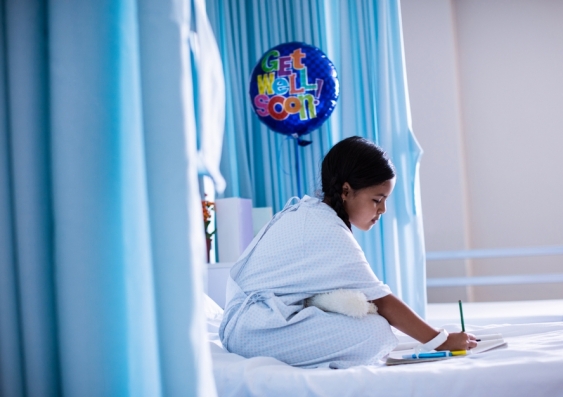Kids hospitalised with chronic illness up to three times more likely to fall behind at school
This is the first large-scale study to measure the academic outcomes of children hospitalised with a chronic condition.
This is the first large-scale study to measure the academic outcomes of children hospitalised with a chronic condition.

Sherry Landow
News & Content Producer
(02) 9065 4039
s.landow@unsw.edu.au
At least one in every 10 kids under the age of 14 live with a chronic health condition.
These conditions – which can include heart disease, diabetes and asthma – affect many areas of a child’s life and, in some cases, can lead to hospitalisations that last days, weeks or even months.
A big data study from UNSW Sydney and University of Sydney has used data from Australia’s standardised school assessment, the NAPLAN, to find out just how much children hospitalised with chronic illness are falling behind.
The findings in more than 300,000 children, published today in Archives of Disease in Childhood, paint a stark picture.
“Our results show that although one in 20 kids may miss the NAPLAN test, this was double (10 per cent) for those hospitalised with a chronic condition,” says co-senior author of the study Raghu Lingam, a professor in paediatric population health at UNSW Medicine & Health and paediatrician at Sydney Children's Hospitals Network.
“Nearly 40 per cent of the most severely affected children – that is, those that were hospitalised more than seven times or more than 15 days – didn't even take the NAPLAN test.
“Those children hospitalised with a chronic condition that did sit the NAPLAN test were at a 30-60 per cent increased risk of not meeting national minimal standards.”
The research is the first large-scale population study to look at how children hospitalised with chronic illness perform compared to their peers. The research team behind the study are part of the Kids to Adults Chronic Illness Alliance (K2A Alliance), a national group of over 200 researchers, clinicians and parents looking at ways to improve the lives of children with chronic illness.

Children who have been hospitalised with a chronic condition have a 30-60 per cent increased risk of not meeting national minimal NAPLAN standards, depending on the subject area being tested. Photo: Unsplash.
The researchers analysed data from a population group of all children born in NSW between 2000 and 2006, with a focus on their NAPLAN results when they were in grades 3, 5 and 7. While the available dataset only included results from public schools (over 300,000 children in total), it still accounted for about two thirds of students in NSW.
Around 16-18 per cent of students in these grades had been hospitalised with a chronic condition before their scheduled NAPLAN tests, which the team identified using a combination of routine birth records and hospital admission records.
Alarmingly, the more hospital admissions or bed-days a child had – regardless of their type of chronic condition – the poorer their academic performance.
The team also found that children hospitalised with mental health or behavioural conditions had the highest risk of poor academic performance compared to other chronic conditions.
Read more: Got a child with COVID at home? Here's how to look after them
“These results show that there's a significant proportion of children in NSW who are facing this challenge,” says co-lead author Dr Joanna Fardell, a senior research fellow at UNSW and neuropsychologist at Westmead Hospital.
“Up until now, we haven't known how many there are and what the impact is for them.”
Prof. Lingam says he hopes the findings lead to broader change and support for these students.
“We all knew this was happening, but the weight of the numbers is huge from a policy and practice perspective,” he says.
“Being able to put a numeric to this shows that we really do need to have additional support for these children and young people with chronic illnesses.”

The NAPLAN gives us a snapshot of how a child's educational trajectory develops over time – trajectories that can predict health, career and wellbeing outcomes later in life. Photo: Shutterstock.
The NAPLAN test – which children in grades 3, 5, 7 and 9 need to sit annually – measures students’ academic skills in reading, writing, spelling, numeracy, grammar and punctuation.
Co-senior author of the study Professor Natasha Nassar, paediatric epidemiologist and chair of translational childhood medicine at the University of Sydney, says that while the NAPLAN isn’t the be all and end all, it does give a population level and standardised view of how well children are performing over time.
“The NAPLAN gives us a snapshot of how those children are going and lets us look at how their educational trajectories develop over time,” she says.
“These trajectories are really predictive of later life outcomes, and can predict whether they complete school, get a job, how they interact in society and even their health and wellbeing.”
Read more: The robots helping sick kids 'teleport' to the classroom
According to Dr Fardell, the NAPLAN may be even more valuable for students who need to spend time in hospital.
“For these kids that are vulnerable, participation in school and standardised assessments is even more important,” she says.
“It's an opportunity to be part of a community, and to be part of a normal developmental process.”

Integrated interventions that include health, education, and psychological support are needed to help these children, the researchers say. Photo: Shutterstock.
Currently, children with physical or behavioural disabilities receive support from government and schools to help their access to education, via Schools for Specific Purposes, access to specialist support teachers and tailored learning and support programs and resources.
But children hospitalised due to chronic illness often fall through these support gaps.
“There is no standardised model of care or policy related directly to children with chronic illness,” says Dr Fardell.
“While there’s support in place for children identified as having a disability, there is this whole other population that just aren't being served under the current set of policies and support structures.”
The researchers say they hope to build on this research with more population and intervention-based studies – this way, they can learn more about the students that need help while also finding the best ways to support them.
Read more: Helping students adapt to online learning sets them up for success
Dr Nan Hu, co-lead author of the paper and research fellow at the UNSW School of Women’s and Children’s Health, says integrated interventions will go a long way in helping these students.
“We need to offer more help to those children affected with chronic conditions – in particular, those who are hospitalised,” he says.
“This should include integrated interventions that incorporate health, education, and psychological support, especially as children hospitalised with mental health or behavioural conditions are at the highest risk of performing below the basic academic requirements.”